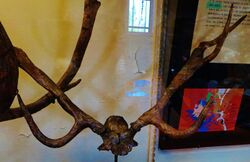Biology:Croizetoceros
| Croizetoceros | |
|---|---|

| |
| Skull of Croizetoceros ramosus | |
| Scientific classification | |
| Domain: | Eukaryota |
| Kingdom: | Animalia |
| Phylum: | Chordata |
| Class: | Mammalia |
| Order: | Artiodactyla |
| Family: | Cervidae |
| Subfamily: | Cervinae |
| Tribe: | Cervini |
| Genus: | †Croizetoceros Heintz, 1970[1] |
| Type species | |
| †Croizetoceros ramosus Croizet & Jobert, 1828
(as Cervus ramosus) | |
| Species | |
| |
Croizetoceros is an extinct genus of deer[2] which lived throughout much of Europe, first appearing during the last stages of the Miocene and living until the Early Pleistocene.
Taxonomy
The type species, Croizetoceros ramosus was originally classified as Cervus ramosus, but was found distinct enough to be placed into its own genus.[3] Many subspecies of C. ramosus have been identified throughout Europe, and another species, C. proramosus, has also been described in 1996.[4]
Description
Croizetoceros was a mid-sized species, similar in size to the living fallow deer. It stood a little over 1 m (3.3 ft) tall and weighed around 60 kg (130 lb).[2] Croizetoceros was one of the first modern-looking deer. It had complex antlers, with four or even five short branches. They were long and lyre-shaped, with the tines branching off tangentially from the central branch.[2]
Croizetoceros was probably a browser.[5] Its teeth were characterized by a high degree of wear, indicating that it fed on abrasive plants.
References
- ↑ "Croizetoceros". https://www.biolib.cz/cz/taxon/id1169403/.
- ↑ 2.0 2.1 2.2 Agustí, Jordi; Antón, Mauricio (2010). Mammoths, Sabertooths, and Hominids 65 Million Years of Mammalian Evolution in Europe. New York: Columbia University Press. p. 205. ISBN 9780231516334.
- ↑ Heintz, E. (1970). "Les Cervidés villafranchiens de France et d'Espagne". Mémoires du Muséum National d'Histoire Naturelle 22: 1–303.
- ↑ Dong, W. (1996). "Les Cervidae (Artiodactyla) rusciniens (Pliocène) du Languedoc et du Roussillon (France)". Bulletin du Muséum National d'Histoire Naturelle 18 (1): 133–163. https://www.researchgate.net/publication/313047308.
- ↑ Strani, F. (2017). "Resource and niche differentiation mechanisms by sympatric Early Pleistocene ungulates: the case study of Coste San Giacomo". Quaternary International 481: 157. doi:10.1016/j.quaint.2017.08.064. Bibcode: 2018QuInt.481..157S. http://zaguan.unizar.es/record/79152.
Wikidata ☰ Q20721944 entry
 |

